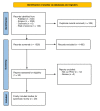A Systematic Review of Laparoscopic Ultrasonography During Laparoscopic Cholecystectomy
- PMID: 38283459
- PMCID: PMC10817818
- DOI: 10.7759/cureus.51192
A Systematic Review of Laparoscopic Ultrasonography During Laparoscopic Cholecystectomy
Abstract
We aim to investigate the potential of laparoscopic ultrasonography (LUS) as a replacement for intraoperative cholangiography (IOC) in the context of laparoscopic cholecystectomy focusing on various aspects related to both techniques. We made our search through PubMed, Web of Science, Cochrane Library, and Scopus, with the use of the following search strategy: ("laparoscopic ultrasonography" OR LUS OR "laparoscopic US" OR "laparoscopic ultrasound") AND ("laparoscopic cholecystectomy" OR LC). We incorporated diverse studies that addressed our topic, offering data on the identification of biliary anatomy and variations, the utilization of laparoscopic ultrasound in cholecystitis, the detection of common bile duct stones, and the criteria utilized to assess the accuracy of LUS. A total of 1526 articles were screened and only 20 were finally included. This systematic review assessed LUS and IOC techniques in cholecystectomy. IOC showed higher failure rates due to common duct catheterization challenges, while LUS had lower failure rates, often linked to factors like steatosis. Cost-effectiveness comparisons favored LUS over IOC, potentially saving patients money. LUS procedures were quicker due to real-time imaging, while IOC required more time and personnel. Bile duct injuries were discussed, highlighting LUS limitations in atypical anatomies. LUS aided in diagnosing crucial conditions, emphasizing its relevance post surgery. Surgeon experience significantly impacted outcomes, regardless of the technique. A previous study discussed that LUS's learning curve was steeper than IOC's, with proficient LUS users adjusting practices and using IOC selectively. Highlighting LUS's benefits and limitations in cholecystectomy, we stress its value in complex anatomical situations. LUS confirms no common bile duct stones, avoiding cannulation. LUS and IOC equally detect common bile duct stones and visualize the biliary tree. LUS offers safety, speed, cost-effectiveness, and unlimited use. Despite the associated expenses and learning curve, the enduring benefits of using advanced probes in LUS imaging suggest that it could surpass traditional IOC. The validation of this potential advancement relies heavily on incorporating modern probe studies. Our study could contribute to the medical literature by evaluating their clinical validity, safety, cost-effectiveness, learning curve, patient outcomes, technological advancements, and potential impact on guidelines and recommendations for clinical professionals.
Keywords: bile duct injury; bile duct stones; choledocholithiasis; intraoperative ultrasound; laparoscopic cholecystectomy; laparoscopic ultrasonography.
Copyright © 2023, Awan et al.
Conflict of interest statement
The authors have declared that no competing interests exist.
Figures
References
-
- Laparoscopic ultrasonography: limits and potential of present technologies. Lirici MM, Caratozzolo M, Urbano V, Angelini L. https://pubmed.ncbi.nlm.nih.gov/8081930/ Endosc Surg Allied Technol. 1994;2:127–133. - PubMed
-
- Routine laparoscopic ultrasound can significantly reduce the need for selective intraoperative cholangiography during cholecystectomy. Machi J, Oishi AJ, Tajiri T, Murayama KM, Furumoto NL, Oishi RH. Surg Endosc. 2007;21:270–274. - PubMed
-
- Update on laparoscopic ultrasonography. McIntyre RC Jr, Stiegmann GV, Pearlman NW. https://pubmed.ncbi.nlm.nih.gov/8081933/ Endosc Surg Allied Technol. 1994;2:149–152. - PubMed
-
- Laparoscopic cholecystectomy: consensus conference-based guidelines. Agresta F, Campanile FC, Vettoretto N, et al. Langenbecks Arch Surg. 2015;400:429–453. - PubMed
-
- Assessment of common bile duct using laparoscopic ultrasound during laparoscopic cholecystectomy. Yao CC, Huang SM, Lin CC, et al. Surg Laparosc Endosc Percutan Tech. 2009;19:317–320. - PubMed
Publication types
LinkOut - more resources
Full Text Sources

